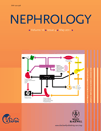Treatment of nephrotic idiopathic membranous nephropathy with monthly i.v. pulse cyclophosphamide and oral steroids: A single centre's retrospective study
ABSTRACT
Aim: While the best treatment of nephrosis-inducing idiopathic membranous nephropathy (IMN) is controversial, some trials have suggested positive outcomes following treatment with oral cyclophosphamide used in combination with steroids. However, data on i.v. cyclophosphamide plus steroids in treatment of nephrotic IMN are few.
Methods: The charts of every patient diagnosed with membranous nephropathy in the Renal Division of Renji Hospital, Shanghai Jiao Tong University School of Medicine, Shanghai, from January 2003 to December 2009 (n = 189) were retrospectively analyzed. Patients with nephrotic IMN (n = 32) were treated with monthly i.v. cyclophosphamide (500–750 mg/m2) and oral prednisone for at least 6 months. Efficacy as well as safety and tolerability of this regimen were evaluated.
Result: Thirty-two patients with nephrotic IMN (56% male, age 51.5 ± 12.6 years, estimated glomerular filtration rate 73.7 ± 20.0 mL/min per 1.73 m2) were included in our study. During the median follow-up duration of 30.0 (12.5–42.8) months, 40.6% of patients achieved complete remission, while 40.6% achieved partial remission. Relapse occurred in five patients in a median of 16 (11.5–26) months after cessation of immunosuppressive treatment. No patients developed renal insufficiency during the follow up, while 16 side-effects were noted in 10 patients. Complete remission rates at 3, 6 and 15 months were 0%, 12.5% and 40.6% and remission rates were 21.9%, 68.8% and 81.2%, respectively. Complement 3 deposition was significantly associated with the probability of non-remission.
Conclusion: Monthly i.v. pulse cyclophosphamide plus oral steroids may be an alternative treatment option in Chinese patients with nephrotic IMN.




